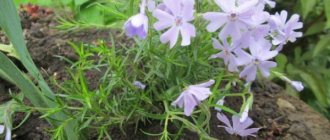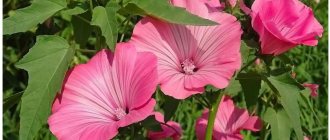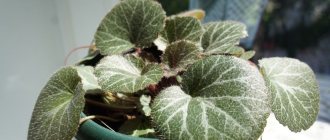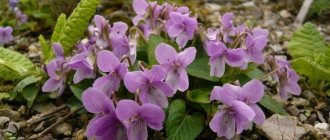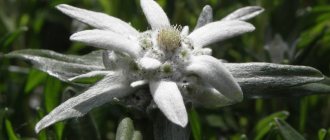Popular varieties
star Rain
Star Rain is a popular Drummonda variety, its distinctive feature is the unusual shape of its petals, usually they have a sharp or slightly pointed shape. Thanks to this handicap, the flowers resemble stars; with the help of this variety you can create a real starry sky in a flowerbed.
Phlox drummond starry
Tetra Riesen
This group of varieties belongs to fairly tall plants; they have fairly large flowers; they can reach 6 cm in diameter.
A variety of colors allows you to choose a plant that will exactly suit your landscape design.
Phlox Tetra Riesen
Feuerbahl
If you are a lover of red shades, then this variety is for you. Phlox of this variety is a plant up to 30 cm in length, which has large flowers of only a red-pink hue. Shades may vary in color intensity.
Phlox paniculata Feuerbahl
Twinkling star
It is not for nothing that this variety was given such a name; its flowers resemble twinkling stars due to the pointed shape of the petals and unusual coloring. Often their color is a gradient, from bright colors to soft pink or white.
Phlox drumonda twinkling star
Protection from diseases and pests
Phlox are strong and hardy plants, but in unfavorable years, as well as when agricultural practices are violated, they can get sick. If you find an infected flower, it is better to immediately dig it up and burn it to save the rest of the plants. If many bushes are affected, it is necessary to combat pests. The most common phlox diseases:
- powdery mildew - a white coating forms on the stems and leaves;
- rust – brown spots appear on stems and leaves;
- phomosis - the above-ground parts become brittle, the leaves become dry;
- septoria - gradually increasing dark spots appear on the leaves;
- variegation - an ugly pattern forms on the leaves;
- Verticillium wilt - high acidity of the soil destroys the root system.
In addition, garden parasites feed on phlox:
- nematodes - thread-like worms that suck the juices from the plant;
- caterpillars - eat petals and leaves;
- cruciferous black flea beetle - parasitizes in the spring, feeding on young shoots;
- slugs - eat leaves, flowers, young shoots;
- slobbering pennice - feeds on juice.
Viral diseases such as variegation cannot be combated. Infected parts of the plant, and sometimes the entire bush, must be immediately removed and destroyed. Otherwise, the diseased flower will infect everyone else.
The most effective drug against fungal diseases is Bordeaux mixture. The affected stems and leaves are removed, and the bush is sprayed with a 1% solution. In the case of powdery mildew, it would be a good idea to treat the plants with a solution of soda ash after a week. In case of Verticillium wilt, the phlox is transplanted to a new location.
Pests are controlled as follows:
- cruciferous black flea beetles are sprayed with Actellik, Decis, Banco;
- caterpillars are destroyed with Karbofos, Inta-vir, and with minor damage they are collected manually;
- the slobbering pennice is treated with Inta-vir, in case of a single lesion, the leaves with the larvae are torn off and burned;
- slugs are caught by hand, the approach to the bushes is sprinkled with lime and ash;
- nematodes are destroyed only by burning.
Pests and diseases - how to deal with them
Modern experienced gardeners know that various herbal decoctions and folk remedies can repel pests and slow down the development of diseases. But only professional methods based on chemical and biological preparations will help destroy insects and cure diseases.
Yellow phlox
- Snails and slugs. Loosen the soil in a timely manner, sprinkle the paths near the phlox with ash, collect by hand and destroy.
- Nematodes. No high-quality protective measures have been invented - it is better to pull out and destroy the affected plants, preventing the spread of the pest.
- Scoops. Collect caterpillars by hand. In case of severe damage, use insecticides.
- Penny is slobbering. Remove damaged leaves and treat with garlic infusion.
- Green wood bug. Spray phlox with onion infusion.
- Cruciferous flea beetles. Dust phloxes with wood ash in the morning.
Control measures depend on the specific disease or pest.
Growing annual flowers requires additional time associated with sowing seeds and planting seedlings. But even if a gardener has to take time away from household chores in order to plant and care for plants throughout the summer season, he will do it without hesitation. After all, beauty is worth it.
Planting and caring for annual phlox
A novice gardener should know: a new specimen of perennial phlox is obtained by dividing the bush; annual phloxes are propagated by self-sowing, seedlings and sowing directly into the ground.
By planting seedlings, you can get flowering phlox in early June, which is a whole month earlier than sowing in the ground, and winter crops will delight you already in May.
Winter method: in the fall, as soon as the leaves fall from the cherries, plant planting material in the prepared soil to a depth of 0.5 cm and cover them until spring.
Important! To obtain a beautiful and lush bush, pinch the top of a young phlox after 6-8 true leaves have formed. The starting material for planting in the fall can be collected from your own plants when the leaves begin to fall:
The starting material for planting in the fall can be collected from your own plants when the leaves begin to fall:
In the flowerbed, select a suitable phlox bush and cut it to the very root. Bring into the room for ripening. Dry by spreading on a towel or paper. Carefully shake out the boxes and separate them from the chaff.
The seeds should be stored in a paper box until spring.
Choosing a site for planting, soil
Phlox loves a lot of sun and does not tolerate rain; it is better to place it in elevated and well-lit places. Before planting, you need to carefully dig up the ground, remove the weed roots, add humus and a little sand. As a result, the soil should be loose and nutritious. The main thing is that there is no clay, phlox does not tolerate it.
Preparing seeds for sowing
To grow healthy seedlings, seed material is prepared in a special way:
- Sprinkle phlox seeds onto a layer of cotton wool and cover them with another layer.
- Moisten the cotton wool with water at a temperature of at least 40 °C.
- Place in a warm place near the radiator if it is not too hot.
- Constantly moisten so that the cotton wool does not dry out.
On the fifth day you can plant.
How to sow seeds for seedlings
Soaked in a special germination solution after 3-5 days, the planting material is ready for planting.
Annual phloxes are sown for seedlings in two ways:
- in a prepared deep container with a damp and loose substrate, spread the seeds on the surface;
- Plant the seeds in a nutrient soil mixture to a depth of no more than 0.5 cm.
Care for both options in the future is the same:
- cover them with film or glass;
- Be sure to open it every morning to ventilate and remove any condensation that has formed;
- During the entire period before emergence, when the surface of the soil dries out, gently moisten it with a spray bottle.
After a week, you can see how the phloxes emerge in different ways: those laid out on the surface - all together, while others will emerge at different times and not all of them.
Note! Seedlings with good care look shiny and soft green
What well-groomed seedlings look like
Rules for caring for seedlings
After the first phlox shoots appear, you can no longer cover the box with film. Young shoots should be watered sparingly, trying not to overdry or overwater. The most dangerous thing is overwatering, as black mold can form.
The box with the young animals should be placed in the sun and turned to the light in different directions so that they do not stretch out.
The temperature should be gradually reduced to 15 °C, this hardens the seedlings.
Phlox should be planted according to the lunar calendar on days favorable for planting.
Important! In more northern areas (Urals, Transbaikalia), where unexpected frosts are possible even in May, it is better not to rush with planting, so as not to destroy young phloxes
Necessary conditions for growing seeds
Perennial phloxes: planting and care in open ground
Knowing some secrets of growing flowers, it is not difficult to achieve success:
- disinfect the soil in boxes with manganese 7 days before planting;
- germination temperature not lower than 18 °C;
- after emergence - up to 21 ° C;
- after a couple of weeks, decrease the temperature regime (hardening) by 7°;
- air humidity not less than 70%;
- Place the container with seedlings on the sunny side.
Having created a favorable climate, seedlings will appear in a week.
Annual Phlox - Phlox Drummond
Phlox Drummond is a beautiful herbaceous flower that amazes with its rich palette of shades.
Unlike perennials, a flower can have a peach, chocolate, beige, coffee, or creamy color.
The plant has thin branched stems that can reach a height of 60 cm.
Drummond can be:
- Star-shaped. Drummond's star can reach 40 cm in height. But you can find a low-growing flower that will reach 15 cm in height. The buds of the star annual have dissected petals that resemble a star with a bright center.
- Large-flowered. It has simple, double or slightly double inflorescences. The height of this species can be about 30 cm.
Benefits of annual Phlox
Considering the features of the annual variety, you can find advantages over perennials:
- To begin with, annuals are rich in bright and varied colors, shapes
- In addition, Phlox Drummond is not whimsical or capricious; it tolerates drought and light frosts well. The plant is more resistant to diseases and pests.
- And unlike perennials, annuals bloom longer.
- This annual has small buds. But since they grow in inflorescences, the flower looks lush and decorative.
Benefits of phlox
In addition, the opposite, slightly oval leaves emphasize its individuality. It is these qualities that make the flower look like a colorful blanket, so it is an excellent option for designing and decorating garden plots, loggias, and balconies.
Star fdoxes
Description and features
Phloxes from the same species may vary as they are influenced by climatic conditions. For example, alpine ones grow from 5 to 25 cm, bryophytes. Their trunks are branching and covered with evergreen foliage. In a favorable climate, the stem of phlox becomes straight, the height is from 30 cm to 1.8 m. The leaves are located opposite, the shape is elongated-ovate or lanceolate-oval. The diameter of the buds is 25-40 mm, tubular-funnel-shaped.
Most species are perennials, but Drummond phlox and its cultivars are annuals.
Diseases and pests
Treating phlox at home is quite possible
But it is important to detect the fact of defeat in a timely manner. Competent flower growers inspect beds and flower beds at least twice a month
The appearance of rust is indicated by the appearance of brown areas on the leaves. The darker the natural color of the plants, the higher the likelihood of such a disease. It is worth remembering that to become infected with a fungus, it is enough for a single spore to fall on the crop. Therefore, the disease recurs even after successful treatment. Rust prevention is carried out using vitriol and other compounds containing copper. The drug is sprayed onto the bushes and onto the surrounding ground.
A more serious danger is variegation. It is very difficult to detect it in a timely manner, because the manifestation of a mosaic virus can be masked by natural stripes. Gradually but steadily, phlox will degrade. The fact of mosaic infection can only be confirmed after examining samples in the laboratory. Phloxes often suffer from jaundice. It is manifested by a lack of flowering, loss of normal flower colors, and a decrease in the length of leaf nodes. Sick specimens are immediately destroyed. Leaves affected by powdery mold are also destroyed. Prevention is provided using soda solutions or diluted pesticides. The main risks from pests are:
- stem nematodes;
- slugs;
- snails;
- scoops;
- bibs;
- green bugs.
Methods for propagating annual phlox
Propagation of annual phlox by seeds
Perennial varieties of phlox can successfully reproduce vegetatively. But for annual specimens, they prefer to grow them using the seed method. Follow these tips when sowing phlox seeds:
- Some gardeners advise sowing phlox seeds for the winter. Plants planted at this time will produce very early and strong shoots in the spring, which will quickly bloom. Sowing is done at the end of October or November. If there is already snow, simply clear the planting area with a shovel. Select an area that will become a permanent place for phlox growth. The seeds are sown at a distance of 4-5 cm from each other and lightly sprinkled with soil. You can buy ready-made nutrient soil. Cover your crops with a snow cap;
- You can sow annual phlox in the spring. Also sow the seeds at a distance of 4-5 cm from each other on the prepared soil. Sprinkle the crops with a thin layer of soil. Phlox should be covered with polyethylene in the spring. Be sure to check your crops, promptly remove condensation from the inside of the shelter, and ventilate the crops. But get ready for the fact that annual phlox planted in the spring will bloom much later than those planted before winter.
Growing annual phlox seedlings
Early flowering of annual phlox can also be achieved by growing seedlings of this plant at home. When can you start sowing phlox seeds at home? It depends on which month the threat of frost passes in your region. You can target the beginning or end of March.
Stock up on phlox seeds in advance
Buy them only from trusted stores, be sure to pay attention to the expiration date. You can also use seeds that were collected by hand if you already grew phlox last year
Select several varieties at the same time to enjoy a real fireworks of colors in the summer. Prepare containers for sowing seeds. These can be containers, boxes, pots, bowls, etc.
- Phlox is unpretentious to the quality and composition of the soil. But you can always buy nutritious soil for ornamental plants, which never hurts.
- Seeds should not be buried in the soil. Just place them on the surface at some distance from each other and press down lightly.
- Cover containers with crops with polyethylene or glass. Place the phlox in a warm and bright place.
- Ventilate phlox regularly and remove water droplets on the inside of the glass or film - condensation.
- Monitor the soil moisture, which should not dry out. Gently spray the phlox with warm water from a spray bottle.
- After the sprouts have 2-3 leaves, they need to be picked into individual containers. You should not expose young phloxes to bright sunlight. Take care to create diffused and soft light. Continue to keep the plants moist.
- Do annual phloxes pinch? As soon as the phlox sprouts its fifth or sixth leaf, you need to pinch them off. This is necessary so that a neat phlox bush begins to form.
- Phlox seedlings do not need to be fed. But applying mineral fertilizer, which can be done twice, will not interfere with the growth of the flower, but will only enhance its decorative qualities.
- About 1 month before the intended planting in open ground, young phloxes need to begin to be hardened. Take the plants outside first for a couple of hours, and then gradually increase the time spent outdoors. In this way, you will prepare the plants as much as possible for outdoor conditions, and they will take root in the new place much better.
Sowing seeds
The timing of planting seeds depends on the climatic conditions of the area in which the phlox will grow. Most often this happens in April-May.
In the northern regions, it is better to plant seeds at the very end of spring. It should be remembered that the later the planting is carried out, the later the flowers will appear. Seeds can also be planted before winter.
General rules for sowing Drummond phlox seeds:
- It is better to plant seeds of plants of the same variety in one bed. If a gardener decides to grow tall phloxes next to dwarf ones, care should be taken to ensure that the bushes are positioned correctly so that small plantings do not grow in the shade.
- In order for phlox of all varieties to bloom at the same time, it is necessary to plant the taller species of Drummonda a month earlier than the shorter ones.
- If you do not follow a certain order when planting seeds and plant them chaotically, the massively sprouted sprouts will interfere with each other’s development, so thinning should be done by removing weak stems.
Phlox subulate from seeds. Phlox subulate: planting and care in open ground
Not everyone likes to tinker in the ground, dig potatoes, grow dill and parsley. But everyone wants their backyard to look presentable. One of the best options is to seed everything with grass or cover everything with artificial grass. But this is quite expensive and troublesome. There is another way - to plant the area with a low semi-shrub creeping along the ground, which received the scientific name phlox subulate.
Botanical description of the plant
Phlox subulate is a perennial ground cover shrub. Botany classifies it as a member of the Sinyukhov family, and from a distance it looks like a blooming lilac creeping along the ground.
Phlox subulate
The main characteristics are as follows:
- Depending on the variety, phlox can be either 5 cm in height or 17 cm, but no more.
- The stems do not tend to the heights at all. They consist of many branches, some of which go back into the ground and put down additional roots there. The maximum length of one branch is 50 cm. The color of the stems is green, and the maximum thickness is up to a centimeter.
- The leaves on the stems are located quite tightly to each other, thereby creating a thick “carpet”. The shape of the leaves resembles an awl, which is reflected in the name of the plant. The leaves are narrow, hard, opposite and rarely grow more than 2 cm.
- The plant's roots go deep to a maximum of 15 cm. But it has many appendages, which allows the phlox to receive the required amount of minerals.
- The most important thing is flowers. In fact, they are small, but thanks to their large number they create a beautiful picture. Each flower is no more than 2-2.5 cm in diameter. Consists of 5 petals forming a flat corolla. There are different colors: white, cream, pink, purple and blue shades.
Phlox subulate, paniculate, splayed and annual: description
There are several dozen varieties of phlox, but they are all divided into 4 separate groups:
Annual phlox: varieties with photos and names
Drummond phloxes became the founders of several unique varieties:
Phlox subulate: varieties with photos and names
Subulate phlox is also divided into several interesting varieties:
Phlox splayed: varieties with photos and names
Spread phlox is divided into the following varieties:
Phlox paniculata: varieties with photos and names
Paniculate phlox is the founder of the following varieties:
How to replant
Perennial flowers have good survival rate. Therefore, if the initially selected area is not suitable for phloxes or they have stayed in one place for a long time, you can fearlessly move them to another flowerbed. Transplantation is usually carried out in late summer or early autumn. During this period, on the one hand, the plant slows down its life processes, and on the other, it has enough time to take root.
Flower growers usually do not have questions about how to replant phlox. The same procedure is carried out as during landing. But you should not overuse fertilizers, especially nitrogen ones. It is better to add potassium and phosphorus, they help the plant quickly adapt to a new place and prepare for wintering.
Flower care during and after flowering
When to plant phlox in open ground in spring
As soon as annual phloxes are transplanted into open ground, their care changes:
- loosen the soil as necessary;
- bushes should be hilled;
- water in the morning or evening;
- apply fertilizers: in May, fertilize with diluted manure (20 g per bucket of water), in June - with superphosphate, in early August - with manure;
- Be sure to cut off dried flowers.
Preparing for winter
In the fall, after collecting the seed material, you need to dig up all the phlox bushes. Perennials overwinter outdoors in warm areas; it is advisable to cover them with compost during the cold season.
Mini phloxes can be transplanted into pots and brought indoors; they will delight you with their beauty for some time.
Cover winter plantings with special covering material for the winter.
What to feed for abundant flowering
In the summer, phloxes must be fed 2-3 times with complex and nitrogen fertilizers.
It’s easy to prepare a natural, nitrogen-rich fertilizer from weeds collected in the garden: pour over the grass, when it’s steeped, dilute it in a ratio of 1:10 and water the plants.
You can add superphosphate once.
Superphosphate
Phlox seeds for seedlings. Growing seeds for seedlings
Annual and perennial phloxes, the planting of which with seeds is quite common, germinate well if they are not deeply buried in the soil. This should definitely be kept in mind, since otherwise the seeds may not germinate or you will have to wait quite a long time for germination, two to three weeks, and they will not be friendly (with surface sowing, seeds usually germinate after 7 days). The easiest way is this: the seeds are scattered over the surface of the soil in plastic containers, watered from a sprayer and covered with a transparent film on top. This is usually done in March. Holes must be made at the bottom of the containers to prevent stagnation of water from being harmful to the seeds. It is better to use special soil for seedlings. Its layer should not be too deep. It is advisable to spill it with a weak solution of potassium permanganate five days before planting, and pre-water it with a solution of phytosporin the day before planting. Seeds should be ventilated daily by opening them and shaking off condensation from the film.
After the appearance of two leaves, the sprouts dive. Seedlings, as a rule, tolerate picking normally. It is only recommended to protect them from direct sunlight in the first two to three days to avoid burns to the tender leaves. Flower growers recommend covering the top of the seedlings with newspapers or opaque film. Phlox grown from seeds for seedlings are planted in the ground at the end of May, best at a distance of at least 20 cm from each other. It will be useful to mulch the soil between young plants to better retain moisture. Periodically, once a month, they should be fed with complex mineral fertilizer. In addition, further care, as in the case of other garden flowers, involves loosening, weeding and regular watering.
Annual phloxes can be sown with seeds in the spring and directly into the ground, but with this method their germination rate will be low. In addition, it should be borne in mind that they bloom only two months after planting. Therefore, growing from seeds to seedlings is preferable in this case.
How to care for phloxes in the country
Phlox are able to survive in difficult conditions, but then flowering will be much more difficult. This culture is cold-resistant.
The best soil for them will be medium loamy, loose and moist, close to neutral (pH 5.5-7.0). Growth and flowering will be successful with the addition of manure, a share of leaf soil, compost and ash; they are combined with organomineral mixtures and mineral fertilizers.
Phloxes have a strong root system. The depth can reach 25-30 cm. It is good to prepare the soil in advance. For spring plantings, this is done in the fall, but for autumn plantings, at least a couple of weeks in advance so that it has the opportunity to settle well. For heavy clay soil, coarse-grained river sand is added. You also need humus, a compost mixture, lime (parameters 250-300 g/m2), a volume of low-lying peat, and mineral types of fertilizers. The soil will have to be dug up many times. Then a homogeneous soil structure will be achieved.
When planting is carried out on sandy soil, the location and size of the potential flower garden is determined in advance. Soil is dug to a depth of 45-50 cm throughout this area. Lay a layer of clay on the bottom. Layer - 15-20 cm. Fertile soil is laid on top, compacted and watered abundantly.
During planting in the fall, phosphorus-potassium fertilizers are added to the holes. For nitrogen-containing and complete complex series, spring is suitable.
Shoots appear in early spring. Seedlings need to be picked when two pairs of true leaves appear. The seedlings are moved to a prepared bed where fertile soil is scattered. A week later, add fertilizing - mullein solution (1 to 20). Maintenance in the future is quite simple. They are watered, the soil is loosened, and fertilizing is added. As the plant grows, the composition of the fertilizer does not change, but the proportions increase. Then the Twinkling Star phloxes will bloom brightly, and their fiery outlines of the inflorescences will delight with their decorative effect.
Diseases of annual phlox
They are divided into viral and fungal. Here are photos of the diseases.
Viral:
- rattling. Light spreading spots on leaves;
- necrotic spotting. Dark brown spots on petals;
- ring spot. White spots covering the plants deform the leaf shape over time;
- leaf curl. The leaves become covered with tubercles, the stems become brittle.
Fungal:
- septirosis. Leads to the death of leaves due to the appearance of gray spots. Then the foliage turns yellow and red;
- powdery mildew. Spider-web spots cause leaves to dry out;
- rust. Brown spots that appear and spread lead to the death of phlox foliage.
In addition, caterpillars, nematodes, slobbering pennies and other pests threaten.
Varieties and types
Phlox paniculata are the most common plant species, which have a number of subspecies:
- Alyonushka is a representative of paniculate phlox, the flowers are painted in a soft pink color, up to 4 cm in diameter. The shape of the inflorescence is quadrangular, quite compacted. It has erect stems, the height of which reaches 50 cm. Flowering occurs in mid-summer and lasts for a month. The flower is resistant to fungal diseases.
- Aurora is a plant with coral pink flowers and a white center. The inflorescence has the shape of a pyramid. Erect stems up to 80 cm high. Flowering occurs in mid-summer for 35 days. The flower is less resistant to fungal diseases.
- Phlox splayed - grows in humid forests, is found in thickets of small forests, but can also grow on poor arid soils and mountain slopes. The flowers are perennial herbaceous plants, the height of which reaches 30 cm. The hard leaves have an oblong shape with a pointed end. The inflorescence is in the form of tassels, up to 10 pcs., flowers up to 2 cm in diameter. They have a pleasant bluish-lilac tint, and there is a dark eye in the center. The flowers emit a delicate fragrance. Flowering occurs in May and lasts up to 30 days. In hot and dry weather they bloom for less time.
- Phlox subulate
- Subulate – this species got its name from the shape of its leaves; they resemble small “awls.” Flowers reach a height of up to 17 cm. It has recumbent stems that spread like a carpet on the ground. The stems have short internodes, which are covered with small, pointed and hard leaves. At the ends of the stems there are peduncles that produce several flowers each. Flowers of pink, white, purple, lilac colors with all sorts of shades, which are collected in small inflorescences. Flowering occurs from late spring to early summer, they bloom again in late summer - early autumn, but not as abundantly as when planting, caring for and propagating lilies.
- Drummonda is a small annual plant in the form of a branched bush, the height of which reaches 50 cm. In summer, small flowers appear on multiple tender shoots, which are collected in complex inflorescences in the form of umbrellas or shields. Under good conditions the plant blooms very profusely. By mid-summer, small boxes, round in shape, ripen, containing fairly large seeds. They are located in the middle of the flower and are difficult to see.
Varieties of low-growing phlox
An ideal option for decorating small flower beds and balconies is a low-growing variety, as well as dwarf phlox. A special feature of this low-growing variety is its long flowering period and thick, durable stems.
Low-growing phlox: terry Promise
Terry phlox drummond "Promise" has pink, white, and peach shades. Corymbose inflorescences of many double, semi-double flowers, up to 3 cm in diameter, are always brightly colored and do not fade in the sun.
On lawns, plants are planted in groups. Its low bushes (up to 25 cm) will look impressive along borders, in the foreground of a flower garden, in containers on a balcony or windowsill.
Period of abundant flowering: end of June - October.
Dwarf phlox: features of the species
A flower crop from the genus Phlox ( Sinyukhova ) belongs to a less common creeping species. The height of the plant does not exceed 30 cm. The stems are green, ascending, which extend from the base (woody). This species has interesting pubescent leaves and large flowers - fragrant, pink with a hint of purple, yellow, white, and lilac. Inflorescences are loose corymbose.
The dwarf species is interesting to flower breeders for its wonderful sunny yellow color of flowers, which distinguishes it from other varieties that do not have this shade. The only sad thing is that the yellow pigment is easily destroyed under the rays of the bright sun.
The plant takes root well on slopes, along borders, garden paths, and in flowerpots. It is wonderful in combination with irises, tulips, aubrieta, as well as jasmine, lilac, and boxwood.
Caring for dwarf phloxes is simple: regular watering, loosening the soil, fertilizing, pruning after the inflorescences have faded. The soil must be nutritious, therefore for its normal growth and flowering it is necessary to fertilize the soil with organic and complex fertilizers.
Low-growing annual aster: growing from seeds
Decoration of the autumn garden - aster. This type of ornamental plants abounds in an incredible variety of sizes, shapes, and color shades. That is, there are varieties - giants up to 2 m tall. Like, for example, the New England aster .
New Belgian asters are slightly shorter in height (80-150 cm). Many people know them as the Sentyabrina and Oktyabrina varieties, and love them for their huge variety of flower shades. By the way, on one bush you can simultaneously count several hundred flowers.
The lowest of the autumn asters is the low-growing annual aster . It is also called Chinese. This plant has a bushy form with straight stems. The leaves are serrated and large. The upper ones are oblong. Flowers of simple or double shape in the most exquisite shades are collected in large beautiful inflorescences.
Currently, flower growers distinguish 4 groups and 600 varieties of this crop.
Aster is grown by sowing. In early spring, the seeds are sown sparsely, maintaining a distance of 20-50 cm between rows. And depending on the height and spreading nature of the variety, the gap between aster seedlings (in the same row) should be from 10 to 30 cm.
Asters begin to bloom in the second half of summer and continue until autumn.
How to pinch annual phlox. Do annual phlox need to be pinched?
Phlox belongs to perennial plants, but there is one representative, according to the type of subspecies of this family, which is called Drummond phlox. This phlox plant just blooms in one season, which is why it is considered an annual.
There is a special complex of care for annual phloxes, which is slightly different from the usual, because you need to have time to fit all the self-care procedures into one season.
Growing annual phlox is a simple matter that repeats itself like a cycle: planting, growing, flowering. There are two ways to plant annual phlox: directly with seeds in the soil mixture, or to germinate these seeds first, and then plant the seedlings that will turn out in open ground. All the characteristics of growing phlox indicate that this plant loves well-lit areas, fertile soils, which means everything that is aimed at developing and improving the well-being of phlox is good.
When considering this point, it is worth paying attention to whether it is worth pinching phloxes when they grow and form leaves. Is this so beneficial for the plant, is it suitable for it? Usually, to activate the rapid growth of plants, they are either replanted or pruned.
Annual phloxes cannot survive transplantation at all; they are much better off if they are treated with some easy means. Pinching is a completely easy and less traumatic way for the plant to make flowering lush and extensive. Phloxes are not pinched immediately, but as the plant grows. As soon as the first small leaves form on it, and there should be at least five or six of them, take those that are closest, and then use your fingers to pinch them together carefully so as not to tear them off. Do a similar procedure with several leaves on the crown, but not so that you grab everything and use it, but so that about half are used, and half are left to the will of the phlox itself to develop.
There is also the practice in open ground of pinching several leaves from different plants, but this is only possible if the plants are planted very densely. There is an exchange of beneficial properties, and there is also a supposed possibility that the plant will only become more magnificent from this. But still, most people practice precisely the technique of pinching annual phlox on one plant, without jumping over or moving to neighboring ones.
Care after pinching should be the same as under normal conditions for phloxes: standard watering, fertilizing the soil so that it remains nutritious and always saturates the phloxes, throughout the entire flowering period of the phloxes, until they fade. In order for nutrients to pass through the soil mixture much better, regularly loosen it around the plant, without touching the soil mixture next to the plant itself, because you risk damaging it a little. The temperature in spring and summer will be quite appropriate, so there is no need to take any additional measures to care for annual phlox, unlike perennial phlox.
How to feed phlox for abundant flowering
During the entire flowering period, it is necessary to carry out 3 nitrogen mineral fertilizing, alternating with organic fertilizers - aqueous extracts of ash, chicken droppings containing potassium and calcium, and herbal infusion.
The first nitrogen fertilizing is carried out before planting seedlings in the flower garden. Then the condition of the plants is observed. Signs of a lack of nutrition will be yellowing of the leaves, inhibited growth of stems, and a decrease in the size of flowers.
Why don't perennial phlox bloom?
Perennial or annual phloxes will not be able to bloom if they grow in dense shade.
Their stems will become thinner and elongated. The plant will devote all its strength to getting to the sun, because without it the processes of photosynthesis will not take place, and there will be no strength left for flowering.
In addition, planting and caring for annual and perennial phlox should ensure that the plants do not suffer from a lack or excess of moisture and nutrients, do not get sick and are not attacked by pests.
When is the best time to plant phlox?
Planting in a flowerbed can be done in spring, summer, and autumn. The longest period is autumn. All work is allowed up to 35 days. Dividing begins in August, and planting ends at the end of September.
Important! You cannot waste time, since the transplanted flower must become well established before the onset of frost. Phlox varieties that bloom late begin to be planted in the second half of September.
But it is best to postpone work in such a situation until the spring.
Phlox varieties that bloom late begin to be planted in the second half of September. But it is best to postpone work in such a situation until the spring.
Planting a plant in the spring is possible only after the snow cover has completely melted. The soil should have time to dry out.
Spring planting of phlox
Plant care
Once the plants are planted in a permanent location, growing them is quite simple. Flowers require regular watering, especially in hot weather. In the first half of the plant's growing season, it is necessary to loosen the soil, but do it carefully, due to the fact that the root system is located close to the surface. After the annual phloxes have become stronger, hilling is carried out to strengthen the root system.
Four times during the growing season it is necessary to fertilize with mineral and organic fertilizers. To prevent the soil from drying out quickly, many gardeners mulch around each plant.
Growing phlox drummond presents virtually no difficulties; this flower is not demanding to care for, so even a novice gardener can grow it.
To plant a phlox flower, you can buy the seeds in the store or collect them yourself after the fruits appear.
How to care for phloxes in the country
Phlox are able to survive in difficult conditions, but then flowering will be much more difficult. This culture is cold-resistant.
The best soil for them will be medium loamy, loose and moist, close to neutral (pH 5.5-7.0). Growth and flowering will be successful with the addition of manure, a share of leaf soil, compost and ash; they are combined with organomineral mixtures and mineral fertilizers.
Phloxes have a strong root system. The depth can reach 25-30 cm. It is good to prepare the soil in advance. For spring plantings, this is done in the fall, but for autumn plantings, at least a couple of weeks in advance so that it has the opportunity to settle well. For heavy clay soil, coarse-grained river sand is added. You also need humus, a compost mixture, lime (parameters 250-300 g/m2), a volume of low-lying peat, and mineral types of fertilizers. The soil will have to be dug up many times. Then a homogeneous soil structure will be achieved.
Diseases and pests (treatment)
All plants are susceptible to disease and are affected by various pests. Annual phlox is no exception.
Diseases
Fungal diseases: phomosis - leaves dry out, stems become brittle. For prevention, bushes are sprayed with colloidal sulfur in warm weather; Septoria - dark spots appear on the leaves, gradually growing. Treat by spraying the plantings and soil with Bordeaux mixture, repeat the treatment after 15 days; powdery mildew - a coating similar to flour appears on the bushes. Such a plant is dug up and burned; it is impossible to cure it.
Variegation. Petals and stems are covered with an ugly pattern. Cannot be treated. Sick specimens are dug up and burned to prevent infection of other plantings.
Verticillium wilt. The disease destroys the root system. The disease is typical for specimens growing in acidic soils.
Pests
Nematode. A thread-like, very small worm that sucks sap from stems and leaves. Diseased seedlings have thinner stems and smaller inflorescences. Such a bush is burned. The soil is treated with nematicides three times with an interval of twenty days.
Naked slugs. In the dark, they eat the lower part of the stem, inflorescences, and leaves. Dusting the soil with ash, tobacco dust, and fluff lime serves as a preventive measure and fights slugs. Systematic loosening of the soil and weeding will also help in the fight against them.
Butterfly caterpillars. Caterpillars are removed by collecting them by hand, and the plantings are treated with special preparations against leaf-eating pests.


